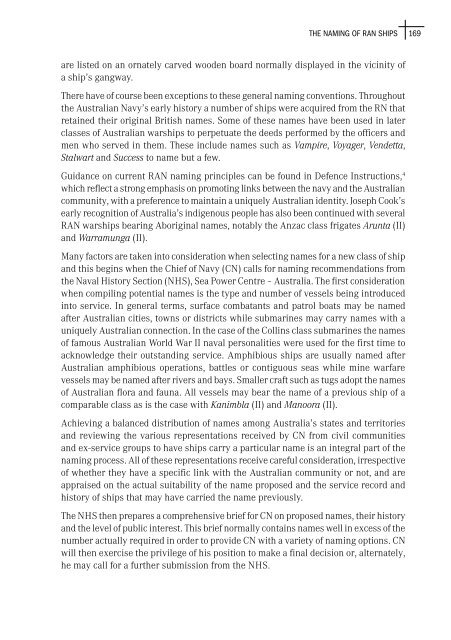Australian Maritime Issues 2007 - Royal Australian Navy
Australian Maritime Issues 2007 - Royal Australian Navy
Australian Maritime Issues 2007 - Royal Australian Navy
Create successful ePaper yourself
Turn your PDF publications into a flip-book with our unique Google optimized e-Paper software.
THE NAMING OF RAN SHIPS<br />
169<br />
are listed on an ornately carved wooden board normally displayed in the vicinity of<br />
a ship’s gangway.<br />
There have of course been exceptions to these general naming conventions. Throughout<br />
the <strong>Australian</strong> <strong>Navy</strong>’s early history a number of ships were acquired from the RN that<br />
retained their original British names. Some of these names have been used in later<br />
classes of <strong>Australian</strong> warships to perpetuate the deeds performed by the officers and<br />
men who served in them. These include names such as Vampire, Voyager, Vendetta,<br />
Stalwart and Success to name but a few.<br />
Guidance on current RAN naming principles can be found in Defence Instructions, 4<br />
which reflect a strong emphasis on promoting links between the navy and the <strong>Australian</strong><br />
community, with a preference to maintain a uniquely <strong>Australian</strong> identity. Joseph Cook’s<br />
early recognition of Australia’s indigenous people has also been continued with several<br />
RAN warships bearing Aboriginal names, notably the Anzac class frigates Arunta (II)<br />
and Warramunga (II).<br />
Many factors are taken into consideration when selecting names for a new class of ship<br />
and this begins when the Chief of <strong>Navy</strong> (CN) calls for naming recommendations from<br />
the Naval History Section (NHS), Sea Power Centre – Australia. The first consideration<br />
when compiling potential names is the type and number of vessels being introduced<br />
into service. In general terms, surface combatants and patrol boats may be named<br />
after <strong>Australian</strong> cities, towns or districts while submarines may carry names with a<br />
uniquely <strong>Australian</strong> connection. In the case of the Collins class submarines the names<br />
of famous <strong>Australian</strong> World War II naval personalities were used for the first time to<br />
acknowledge their outstanding service. Amphibious ships are usually named after<br />
<strong>Australian</strong> amphibious operations, battles or contiguous seas while mine warfare<br />
vessels may be named after rivers and bays. Smaller craft such as tugs adopt the names<br />
of <strong>Australian</strong> flora and fauna. All vessels may bear the name of a previous ship of a<br />
comparable class as is the case with Kanimbla (II) and Manoora (II).<br />
Achieving a balanced distribution of names among Australia’s states and territories<br />
and reviewing the various representations received by CN from civil communities<br />
and ex-service groups to have ships carry a particular name is an integral part of the<br />
naming process. All of these representations receive careful consideration, irrespective<br />
of whether they have a specific link with the <strong>Australian</strong> community or not, and are<br />
appraised on the actual suitability of the name proposed and the service record and<br />
history of ships that may have carried the name previously.<br />
The NHS then prepares a comprehensive brief for CN on proposed names, their history<br />
and the level of public interest. This brief normally contains names well in excess of the<br />
number actually required in order to provide CN with a variety of naming options. CN<br />
will then exercise the privilege of his position to make a final decision or, alternately,<br />
he may call for a further submission from the NHS.
















